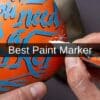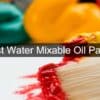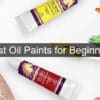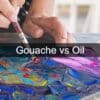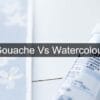Water Soluble Oil Paints vs Traditional
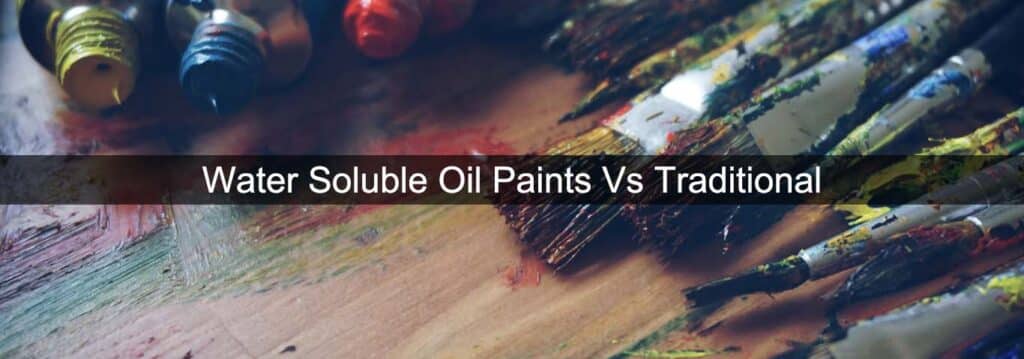
There are two main types of oil paint: water-soluble and traditional. Each type has its own unique set of benefits and drawbacks.
In this article, we will compare and contrast the two types of oil paints to help you decide which is best for your needs.
Water soluble oil paints are a newer type of oil paint that allows you to clean your brushes and palette with just water – no turpentine or other harsh chemicals required. This makes them much more user-friendly, especially for beginners. They also tend to be less toxic and have fewer fumes than traditional oil paints. However, water-soluble oil paints can be more difficult to work with, as they dry quickly and can be tricky to re-wet once they’ve dried.
Traditional oil paints have been used by artists for centuries and are still the preferred medium of many professional painters. They require the use of turpentine or other solvents to clean brushes and palettes, which can be messy and smelly. They also take longer to dry, giving you more time to work with them. However, traditional oil paints are generally more forgiving than water-soluble paints and can be easier to re-wet if they start to dry out.
So, which type of oil paint is best for you? It really depends on your needs and preferences. If you’re a beginner, or if you want to be able to clean up with just water, water-soluble oil paints may be the way to go. If you’re an experienced painter who wants more control over your work, or if you don’t mind using smelly solvents, traditional oil paints may be a better choice. Whichever type of oil paint you choose, make sure to read the labels carefully and follow the directions to ensure the best results.
Introduction of water-soluble oil paints and traditional oil paints
Before digging into the differences, let us fully understand what a water mixable oil paint and a traditional oil paint are! Both the paints have unique characteristics based on different binders.

Water soluble oil paints are oil paints that can be diluted and cleaned with water rather than solvents. They are also known as water-mixable oil or water-miscible oil paints. They contain dry pigments, (color) an oil binder and an additive used in the manufacturing process that acts as an emulsifier. The water mixable oils used are usually modified water mixable linseed oil or modified safflower oil. They are environment and pet friendly.
Traditional oil paints are made of pigment powder and oil, usually linseed oil. It is not mixed with water or with any water mixable medium. People have been enjoying painting with oils for hundreds of years that is why it’s known as the traditional way. They are particularly popular for their versatility and classic feel.
Mediums or binders
Paint binders or mediums are used to firmly attach the pigment to the surface and into a continuous paint film. The type and the quantity of binder used in the painting impact performance factors, such as durability, stain resistance, adhesion, and resistance to cracking.
For water-soluble or water mixable oil paints, low molecular mass resins like polyesters and vinyl acetate copolymers are used. Gum arabic is also a known binder. It is a water-soluble resin from the acacia tree. Water mixable oils like linseed oil or modified safflower oil or walnut oil are also used as a binder.
Linseed as a binder for oil paint has proven to have the best properties. For more than five hundred years, linseed oil has been the most important binders for traditional oil paint. It is pressed from the seed of the flax plant. Poppy and walnut oil are also used. Coconut oil, Olive oil, and Sunflower oil can also be used too.
Choosing and preparing the surface
To compare these two types of oil paints, the surface of the paper does not really create a huge difference.
For water soluble oil paints, untreated surfaces such as paper, cardboard, wood, cotton, and linen can be prepared with gesso so that they are ready to accept water soluble oil paint.
For regular oil paint, gesso is also the main ingredient for surface preparation. Many people associate traditional oil paintings with canvas art, but in fact, regular oils can be used on a number of surfaces such as canvas, paper, wood, and even some metals such as copper and aluminium.
Brushes
Brushes are a bit different for these two classifications of oil paint. Though you can use all types of brushes, it is better to stick to one kind.
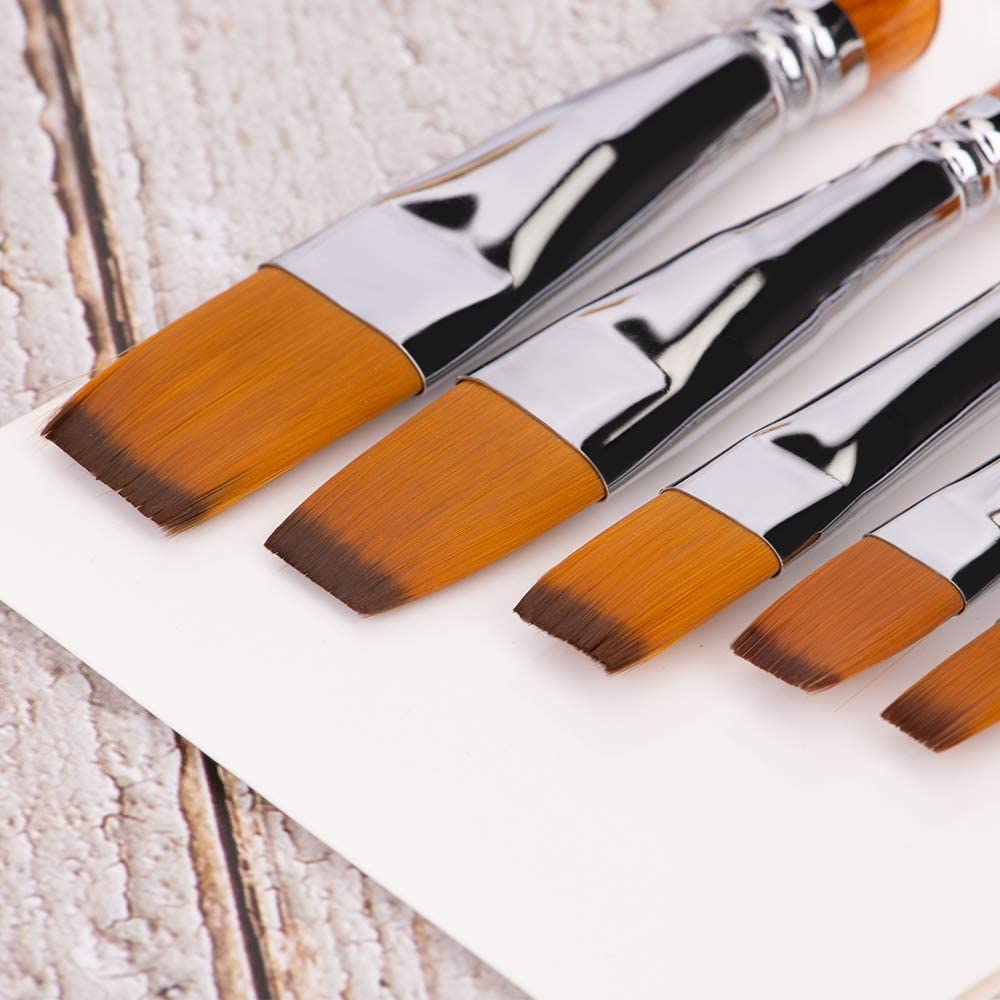
Synthetic brushes work best for water mixable oil paint. They are easy to clean and allow you to draw fine detail with water mixable paint. Natural-bristle brushes are not preferred for water mixable oil colours because they draw moisture out of the water-based paint, making it difficult to apply properly and difficult to clean.
For regular oil paints, natural hog bristle brushes are great because they have good stiffness. For oil painting, it’s recommended that you choose a hog bristle brush or natural hair brush, as it will last you longer and give precise results every time. Also, it is easier to clean regular oils from natural hair brushes.
Cleaning the brushes
For most artists, cleaning your brushes is never a pleasurable task after painting, but with oils, it can be even more of a pain.
Usually, a watery wash should be enough for paints like gouache or watercolor, but with oil paints, it is totally different.
Cleaning off water-soluble paints, you need only soap. You can clean up easily with just soap and water. A mild detergent and warm water can work like magic. To soften dried-on paint, use hot soapy water, and soak the brushes, it will help remove the remainder of the paint. Another best solution is using baby oil, and you’ll see just a few drops will be enough to clean out the colours. Murphy’s oil soap can be a good choice for cleaning your brushes.
Solvents, such as turpentine, paint thinner, and mineral spirits, are the most common brush cleaners for oil painters. All three options are incredibly effective, but they do have toxic properties. When using solvents to clean brushes, be sure to do so in a well-ventilated area and to wear a mask. Soaps can also be used to clean traditional oils. Having some soap on hand is a crucial tool in effectively cleaning oil painting brushes.
Drying Time
Now here it is, drying time makes a huge difference between these two.
If you are using water to dilute the paint, then it dries in two stages. The first stage is the evaporation of the water, it will then start the second stage, a further curing process, drying by oxidation, which is exposure to the air, just exactly the same as traditional oils. Water-mixable oil paintings cannot be reactivated with water when dried. Water mixable oils dry by oxidation. They dry a little faster than traditional oils but much more slowly than acrylics, remaining workable for approximately forty-eight hours. And obviously, thicker paint takes more time to dry than thin paint.
Drying times for the traditional oils are a couple of days longer than water mixable oil paints. Once painted, they become touch dry after 18 to 24 hours. The thickness of impasto will make a difference to the drying times, obviously the thinner the layer of paint, the quicker the drying time once again. They are very slow at drying, and you have to be patient. Sometimes, it takes months for thick paint to fully dry.
Mixing with colors
Mixing with each other
Yes, amazingly, with every brand of water-mixable oil paints, you can even add a small amount of up to 20-30% of traditional paints in with your mix, and they still remain water-soluble paint. Normal or traditional oil paints will mix with water-soluble oil paints, but you will find that the more traditional oils you add, the less water-mixable the paint becomes. You can also mix mediums made for traditional oils with water soluble oil paints, although these, too, will affect the water solubility of the paint.
Mixing with acrylic paint
You can mix acrylic paints with your water soluble oil paints. Before mixing up, check the acrylic paint manufacturer to ensure that it is, in fact, mixable with water-soluble oils. It is not possible to use just any acrylic with water mixable oil paint, so be sure to research the brands you intend to use.
Generally, it is not a good idea to mix real oil paints and acrylic paints together on your palette before applying them to the canvas. Acrylics are water-based, and oils are oil-based, so they each have different properties and different needs.
Mixing with watercolor or gouache paint
You can mix water soluble oil paints with water and so do not need any solvents. So, it can be said that water mixable oil paints can be mixed with watercolor and gouache as well. The one aspect you may enjoy even more is the ease of creating transparent glazes and water-washed underpaintings by mixing these two types of colors. This is where the ability to mix the pigment with water is very helpful.
You can mix traditional oils with watercolor or gouache. The rich tone that immediately comes through from the oil enhances the gouache base and builds a solid color look without much additional effort.
Thinning the paint
Thinning the paint is the most important part of oil painting. Though you can paint straight from the tube be sure to use the right amount of thickness or thinness in order to create the exact color you are aiming for.
Using water as a thinner with water-soluble oil paints, once the initial water evaporates, it leaves a paint film which can be slightly tacky. Water soluble oils mixed with water-soluble linseed oil and other water mixable oils do not have this tackiness. Thinning water-soluble oil paints with water can cause a color shift. The paint becomes lighter in color but darkens to its original color as the water evaporates. Water-soluble mediums made for use with water-soluble oil paints do not have this effect. Traditional linseed oil can be used to thin water-soluble oils, and it will give the painting a nice sheen and add depth to the color. You can also use the famous cobra water mixable oils to thin down your paint. There are also specially formulated linseed, safflower, and other oils designed to work with these non-traditional oils.
While you can use water-to-thin water soluble oil paints, it may not be your best option to do with traditional ones. Straight water will often create a duller color and stickier paint that doesn’t brush easily or work well when other oils are added. In fact, painting with a dry brush will give you a more textural effect, which is perfect for painting brick or dirt. The most basic way to thin oil paint is by using a solvent such as mineral spirits or turpentine. Solvents will thin the paint very rapidly and thoroughly and are low viscosity, which means they have a more watery consistency. Gamsol is an excellent solvent for thinning oil paints and other media and is available in 32-ounce and 1-litre bottles. It is an odorless, non-toxic solvent and is safer than turpentine both for painters and for the environment. The choice of oil imparts a range of properties to the paint, such as the amount of yellowing or drying time.
Toxicity of the paints
The toxicity of the paints is harmful to the environment, animals, and to the oil painter himself.
Water soluble oil paints are non-toxic. They are good for people who are allergic to the solvents normally used with oil paints, work in close quarters or with other people in a studio, and want to eliminate the odor and fumes of the solvents. It’s safe to use around family and pets. It is safer for painters and for the environment.
There isn’t anything inherently toxic about a tube of oil paint. It’s the thinner or solvent that you mix in with conventional oil paint that can cause issues. The strongest smelling, most toxic thinner used in the traditional oil painting process is distilled turpentine. There are certain pigments such as cadmium, lead, and paints containing heavy metals that are hazardous, but these are always labelled as such on the tubes, and they’re at their most risky when in a dry powder form. Other solvents like distilled turpentine, white spirit, and mineral spirits/ odorless mineral spirit are also toxic, and burning them creates toxic fumes which are harmful to the environment.
FAQ’S
Can you paint straight from the tube?
Yes, you can. But by adding tiny oil droplets or a bit of water, this usually helps in most cases since it’s then easier for you to paint smoothly and blend in where required.
Is it necessary to clean brushes?
Failing to clean oil paints off brushes can ruin them very quickly. In fact, leaving paint on your brushes overnight can damage the bristles for good. In order to protect your investment, you will want to keep the bristles clean and healthy.
Which one is environment friendly?
Because of the solvents that are used, water mixable oil paints are environmentally friendly. They are pet and human-friendly too. So, you do not need any masks or proper ventilation while painting with water mixable oils.
Do I need different art supplies for these two?
No. You can use the exact same art materials but make sure to use different bristles.
Which paint takes more time to dry?
Definitely, traditional paint takes more time than water mixable ones. It can differ in paint layers, paint flow, or the mediums that are being used.
Affiliate Disclosure
In compliance with the FTC guidelines, please assume the following about all links, posts, photos and other material on this website: Any/all of the links on this website are affiliate links of which The Big Red Illustration Agency receives a small commission from sales of certain items, but the price is the same for you. www.bigredillustrationagency.com is a participant in the Amazon Services LLC Associates Program, an affiliate advertising program designed to provide a means for sites to earn advertising fees by advertising and linking to Amazon.com & Amazon.co.uk. Pages on this site may include links to Amazon and its affiliate sites on which the owner of this website will make a referral commission.
FULL TERMS HERE Cookie preferences: cookie preferences

Written By Adam Rushton
Adam has made a name for himself in the illustration industry and is a passionate blogger and writer on the subject of art, illustration and graphic design.
His artwork has been featured in countless publications and used for very well-known media projects. As a professional illustrator for over 20 years, Adams media outlets, a wealth of knowledge, and experience enable him to consult and advise artists and illustrators in this country (from York and Manchester to Southampton and London) and all over the world.


